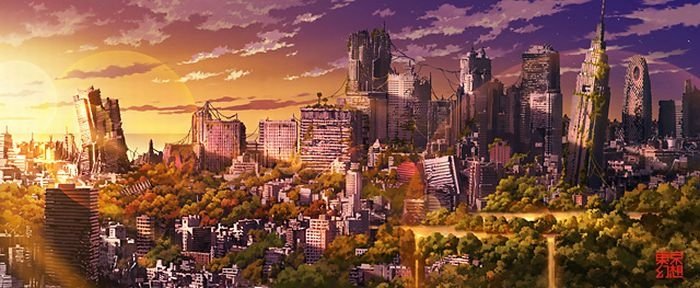|
|
Post-apocalyptic Pictures Of Tokyo
|
The 1885 novel After London by Richard Jefferies is of the type that could be best described as genuine "post-apocalyptic fiction"; after some sudden and unspecified catastrophe has depopulated England, the countryside reverts to nature, and the few survivors to a quasi-medieval way of life. The first chapters consist solely of a loving description of nature reclaiming England: fields becoming overrun by forest, domesticated animals running wild, roads and towns becoming overgrown, the hated London reverting to lake and poisonous swampland. The rest of the story is a straightforward adventure/quest set many years later in the wild landscape and society; but the opening chapters set an example for many later science fiction stories. Similarly, Stephen Vincent Benét's short story "By the Waters of Babylon" (1937) describes a young man's coming-of-age quest to a ruined New York City after an unspecified disaster.
Published in 1898, H.G. Wells' novel The War of the Worlds depicts an invasion of Earth by inhabitants of the planet Mars. The aliens systematically destroy Victorian England with advanced weaponry mounted on nearly indestructible vehicles. Due to the famous radio adaptation of the novel by Orson Welles on his show, Mercury Theatre, the novel has become one of the best known early apocalyptic works. It has subsequently been reproduced or adapted several times in film, television, radio, music, and computer games.
The period of the Cold War saw increased interest in this subgenre, as the threat of nuclear warfare became real. Paul Brians published Nuclear Holocausts: Atomic War in Fiction, a study that examines atomic war in short stories, novels, and films between 1895 and 1984. Since this measure of destruction was no longer imaginary, some of these new works, such as Mordecai Roshwald's Level 7, Nevil Shute's On the Beach and Pat Frank's Alas, Babylon, shun the imaginary science and technology that are the identifying traits of general science fiction. Others include more fantastic elements, such as mutants, alien invaders, or exotic future weapons such as James Axler's Deathlands. A seminal work in this subgenre was Walter M. Miller, Jr.'s A Canticle for Leibowitz (1959). Ideas such as a recrudescent Church (Catholic or other), pseudo-medieval society, and the theme of the rediscovery of the knowledge of the pre-holocaust world were central to this book.
|
|









